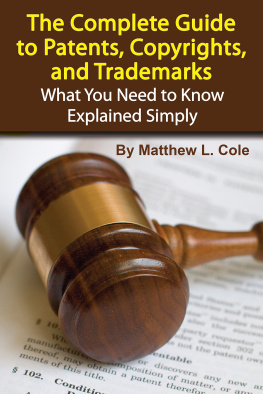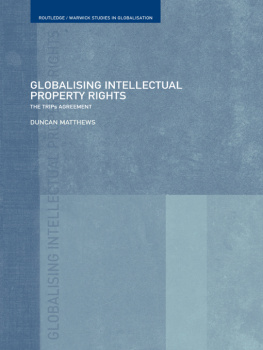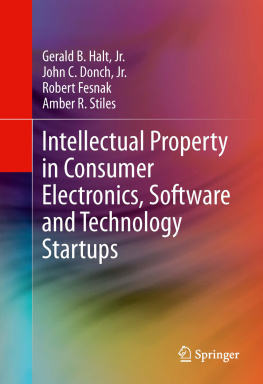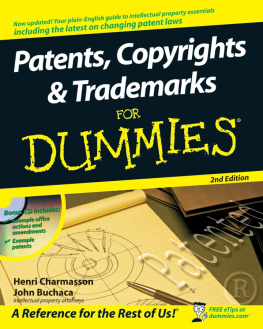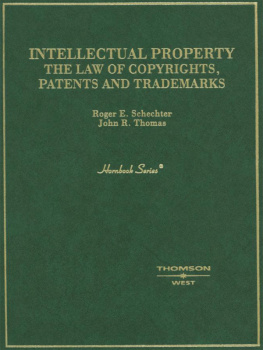GUIDE TO INTELLECTUAL PROPERTY
STEPHEN JOHNSON studied genetics at Cambridge University before qualifying as a solicitor in 1982. He subsequently also qualified as an attorney and worked in the US for Kirkland & Ellis LLP for over thirty years, most recently in San Francisco. He now focuses on intellectual property (IP) from a business perspective and also consults for the US charity One Mind on IP and other policy issues affecting neuroscience research. In 2015 he was named as one of the worlds leading IP strategists by Intellectual Asset Management in its IAM Strategy 300 survey.
OTHER ECONOMIST BOOKS
Guide to Analysing Companies
Guide to Business Modelling
Guide to Business Planning
Guide to Cash Management
Guide to Commodities
Guide to Country Risk
Guide to Decision Making
Guide to Economic Indicators
Guide to Emerging Markets
Guide to the European Union
Guide to Financial Management
Guide to Financial Markets
Guide to Hedge Funds
Guide to Investment Strategy
Guide to Management Ideas and Gurus
Guide to Managing Growth
Guide to Organisation Design
Guide to Project Management
Guide to Supply Chain Management
Numbers Guide
Style Guide
Book of Business Quotations
Book of Isms
Brands and Branding
Business Consulting
Business Strategy
Buying Professional Services
The Chief Financial Officer
Economics
Frugal Innovation
The Great Disruption
Managing Talent
Managing Uncertainty
Marketing
Marketing for Growth
Megachange the world in 2050
Modern Warfare, Intelligence and Deterrence
Organisation Culture
Successful Strategy Execution
Unhappy Union
Directors: an AZ Guide
Economics: an AZ Guide
Investment: an AZ Guide
Negotiation: an AZ Guide
Pocket World in Figures

GUIDE TO INTELLECTUAL PROPERTY
What it is, how to protect it, how to exploit it
Stephen Johnson

The Economist in Association with
Profile Books Ltd. and PublicAffairs
Copyright The Economist Newspaper Ltd, 2015
Text copyright Stephen Johnson, 2015
First published in 2015 by Profile Books Ltd. in Great Britain.
Published in 2015 in the United States by PublicAffairs,
a Member of the Perseus Books Group
All rights reserved.
No part of this book may be reproduced, stored in or introduced into a retrieval system, or transmitted, in any form or by any means (electronic, mechanical, photocopying, recording or otherwise), without the prior written permission of both the copyright owner and the publisher of this book, except in the case of brief quotations embodied in critical articles and reviews. For information, address PublicAffairs, 250 West 57th Street, 15th Floor, New York, NY 10107.
The greatest care has been taken in compiling this book. However, no responsibility can be accepted by the publishers or compilers for the accuracy of the information presented.
Where opinion is expressed it is that of the author and does not necessarily coincide with the editorial views of The Economist Newspaper.
While every effort has been made to contact copyright-holders of material produced or cited in this book, in the case of those it has not been possible to contact successfully, the author and publishers will be glad to make amendments in further editions.
PublicAffairs books are available at special discounts for bulk purchases in the U.S. by corporations, institutions, and other organizations. For more information, please contact the Special Markets Department at the Perseus Books Group, 2300 Chestnut Street, Suite 200, Philadelphia, PA 19103, call (800) 8104145, ext. 5000, or e-mail special.markets@perseusbooks.com.
Library of Congress Control Number: 2015939618
ISBN 978-1-61039-461-1 (PB)
ISBN 978-1-61039-462-8 (EB)
First Edition
10 9 8 7 6 5 4 3 2 1
In memory of Glen Hess
A great business lawyer, and a great human being
Figures and tables
Figures
Tables
Preface
I HAVE WORKED IN INTELLECTUAL PROPERTY LAW for over 30 years, initially at Bird & Bird in London and then at Kirkland & Ellis LLP in Chicago, New York and San Francisco. I now work with a not-for-profit organisation focusing on IPs role as an incentive for research.
The idea behind this book was to write a guide for business people and investors explaining the strengths and weaknesses of patents as collateral (security) for loans. That was over six years ago and there was a huge lack of communication between the worlds of finance and IP. Today, patents are increasingly being used as collateral and a market for patents is developing. However, IP remains an opaque area for many business people. The scope of the book has expanded, but the idea is to try to shed some practical, business-focused light on IP.
After starting my career in London, I arrived in the US at the end of 1982, which marked the founding of a new specialist patent appeals court, the Court of Appeals for the Federal Circuit, and the beginning of a new appreciation of the economic importance of strong intellectual property rights, initially in the US, then in Europe and the rest of the world. As a result, patents emerged from an obscure backwater and now play a central role in many industries. During the same period, the rise of the personal computer and the expansion of international brands led to the growth of industries based on copyright and trademarks, and IP assumed huge business importance throughout the world.
Today, however, the function of patents in stimulating innovation has been called into question by the mass of patent litigation in the smartphone industry and the activities of businesses that acquire existing patents simply to enforce them. The trend towards strengthening patent rights in the US has started reversing.
Legal mechanisms have also failed to cope well with the rampant piracy enabled through technology and the internet, and the balance of rights between the owners of intellectual property such as films and television shows and users of the internet remains a national political and international diplomatic issue. The law remains in constant movement and fundamental questions remain to be answered, or if answered in the past, are subject to review and revision.
Despite this uncertainty, an international IP strategy can still be developed, largely thanks to the legal frameworks established comparatively early in the history of industrialisation by such treaties as the Berne Convention on copyright in 1886. These treaties set out an international order for patents, trademarks, designs and copyrights, resulting in a degree of uniformity of general principles. This process of convergence continued in the 20th century globally and notably within the European Union, where, for example, UK IP law now relies heavily on European concepts.
Although an international IP strategy can be developed, it has to be implemented locally in major markets throughout the world. Considerable differences in IP law remain at a national level, even within the EU, and thus there may be differing results in individual countries.
In attempting to cover what is now a huge field (and to keep it a manageable size), this book is painted in parts with a broad brush, with an emphasis on the US, followed by the UK and Europe. However, Asia and especially China have become much more important with regard to IP. China is often characterised as a haven for copyists, but the reality is that the Chinese government and Chinese businesses are highly focused on filing for IP rights. Western businesses that ignore China in their IP strategy may well regret that decision in the future. In 2014 the first patent case addressing important issues on patents on industry standards reached the European Court of Justice. Tellingly, that case was not between US or European companies but between two Chinese groups, Huawei and ZTE.
Next page

